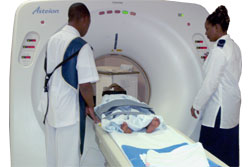- What is renal cancer?
- Disease site
- Macroscopic features
- Microscopic features
- How is kidney cancer detected?
- Prognosis
What is renal cancer?

The three major types of RCCs are:
- Clear cell carcinoma– 75–85% of RCCs;
- Papillary cell carcinoma– 10–15% of RCCs; and
- Chromophobe carcinoma– 3–5% of RCCs.
Disease site
Clear cell RCCs generally develop as a solitary tumour; however, multiple tumours within one or both kidneys can rarely occur. This form of RCC can also occur in association with an inherited genetic disease known as von Hippel-Lindau syndrome (an inherited disease which causes both benign and malignant tumours).
Chromosomal changes are frequently seen in people with clear cell RCCs and these changes increase the likelihood of tumours occurring as they affect an important tumour-suppressing genetic sequence that normally helps the body to identify and kill cancer cells.
Papillary RCCs most frequently develop as a single tumour in one kidney. They can occur in association with other illnesses, known as hereditary renal cancer syndromes. Hereditary syndromes include:
- Hereditary papillary renal cell cancer syndrome;
- Hereditary leiomyomatosis; and
- Birt-Hogg-Dubé syndrome.
Chromophobe RCCs occasionally present as multiple tumours that can affect one or both kidneys. They can occur spontaneously or in association with Birt-Hogg-Dubé syndrome, a hereditary genetic disease.
 |
For more information about the components of the renal system and how they function, see Urinary System (Renal System). |
Macroscopic features

Papillary RCCs are usually solitary tumours in one kidney but can be multiple or occur in both kidneys. Typically, papillary RCCs have a thick outer capsule and the surrounding tissue may or may not be inflamed. There are two types of papillary RCCs (Type 1 or Type 2 papillary RCC); however, only microscopic differences distinguish these types.
Chromophobe cell RCCs also have well-defined borders but are generally tan brown in colour. On first detection they have a mean diameter of 8 cm (larger than other RCC types) and occasionally present as multiple tumours or in both kidneys.
Microscopic features
Clear cell RCCs are so called as the cancerous cells themselves are clear with a well-defined border. Papillary cell RCCs are so called due to their microscopic growth pattern which consists of small, rounded protuberances or “papillae”. Alternately, chromophobe cell RCCs consist of microscopic tubular structures.
How is kidney cancer detected?

The average age at diagnosis of clear cell RCC is 60 to 64 years and is more commonly found in men and in black populations. Only 7% of cases occur in people aged less than 40 and it is rarely seen in children.
Individuals with papillary RCC typically present in the 3rd to 8th decades of life and are more commonly male. When diagnosed, papillary RCCs tend to be smaller and at an earlier stage than clear cell RCCs. The lung is the commonest site to which papillary RCC spreads and these tumours appear to spread less than clear cell RCCs.
Chromophobe RCC is diagnosed mainly in the 6th decade of life and men and women are equally likely to develop it. They are often diagnosed at an early stage and spread to the liver or the lung are the most common metastasis destination.
Prognosis
The overall prognosis for any RCC depends on the degree of advancement (cancer stage) at the time of diagnosis. 40–50% of people with RCC will eventually develop metastatic disease, which is associated with a poorer prognosis. Of all types, clear cell RCC has the worst prognosis with 5-year survival rates between 50 and 69%.
Papillary RCCs metastasise (spread to other sites in the body) less frequently than clear cell RCCs; however, they have similar sites of distant metastases (lung, bone and brain). When this type of RCC spreads into nearby blood or lymphatic vessels survival is reduced in comparison to clear cell RCC that has spread into nearby vessels.
Chromophobe cell RCCs generally have a more prolonged, less aggressive course and a more favourable disease outcome compared with clear cell RCC and have a slightly better or similar survival rate compared to papillary RCC.
 |
For more information about the treatment options that are available for RCC and how effective they are, see Treatments for Renal Cell Carcinoma (RCC). |
References
- Rini BI, Campbell SC, Escudier B. Renal cell carcinoma. Lancet. 2009;373 (9669): 1119-32. [Abstract]
- Presti JC, Rao PH, Chen Q, et al. Histopathological, cytogenetic, and molecular characterization of renal cortical tumors. Cancer Res. 1991; 51: 1544. [Abstract | Full Text]
- Cairns P. Renal cell carcinoma. Cancer Biomark. 2010; 9 (1-6): 461-73. [Abstract | Full Text]
- Grignon DJ, Che M. Clear cell renal cell carcinoma. Clin Lab Med. 2005; 25(2): 305-16. [Abstract]
- Webster WS, Thompson RH, Cheville JC, et al. Surgical resection provides excellent outcomes for patients with cystic clear cell renal cell carcinoma. Urology. 2007; 70:900. [Abstract]
- Yoshida MA, Ohyashiki K, Ochi H, et al. Cytogenetic studies of tumor tissue from patients with nonfamilial renal cell carcinoma. Cancer Res. 1986; 46: 2139-2147. [Abstract | Full Text]
- Sukosd F, Kuroda N, Beothe T, et al. Deletion of chromosome 3p14.2-p25 involving the VHL and FHIT genes in conventional renal cell carcinoma. Cancer Res. 2003; 63: 455-457. [Abstract | Full Text]
- Reuter VE. The pathology of renal epithelial neoplasms. Semin Oncol. 2006; 33: 534–543. [Abstract]
- Smith JW, Sallman AL, Williamson MR, Lott CG. Acquired renal cystic disease: Two cases of associated adenocarcinoma and a renal ultrasound survey of a peritoneal dialysis population. Am J Kidney Dis. 1987; 10: 41. [Abstract]
- Murphy WM, Beckwith JB, Farrow GM, et al. Tumors of the kidney, bladder, and related structures (3rd edition). Washington, DC: Armed Forces Institute of Pathology; 1994.
- Rakozy C. Kidney tumor – adult malignancies [online]. PathologyOutlines.com, Inc; 19 January 2012 [cited 1st April]. Available from: URL link
- Chow WH, Devesa SS, Warren JL, Fraumeni JF Jr. Rising incidence of renal cell cancer in the United States. JAMA. 1999; 281(17): 1628-31. [Abstract | Full Text]
- Vikram R, Ng CS, Tamboli P, et al. Papillary renal cell carcinoma: radiologic-pathologic correlation and spectrum of disease. Radiographics. 2009; 29(3): 741-54. [Abstract | Full Text]
- Cohen RJ, Weinstein S, Robertson T, et al. Variant chromophobe renal cell carcinoma. Arch Pathol Lab Med. 2000; 124(6): 904-6. [Abstract | Full Text]
- Amin MB, Paner GP, Alvarado-Cabrero I, et al. Chromophobe renal cell carcinoma: histomorphologic characteristics and evaluation of conventional pathologic prognostic parameters in 145 cases. Am J Surg Pathol. 2008; 32(12): 1822-34. [Abstract]
- Jemal A, Siegel R, Ward E, et al. Cancer statistics, 2008. CA Cancer J Clin. 2008; 58: 71. [Abstract | Full Text]
- Cohen HT, McGovern FJ. Renal-cell carcinoma. N Engl J Med. 2005; 353: 2477-90. [Abstract]
- Bonsib SM. Renal lymphatics, and lymphatic involvement in sinus vein invasive (pT3b) clear cell renal cell carcinoma: a study of 40 cases. Mod Pathol. 2006; 19(5): 746-53. [Abstract | Full Text]
- Mai KT, Landry DC, Robertson SJ, et al. A comparative study of metastatic renal cell carcinoma with correlation to subtype and primary tumor. Pathol Res Pract. 2001; 197(10): 671-5.[Abstract]
- Patard JJ, Leray E, Rioux-Leclercq N, et al. Prognostic value of histologic subtypes in renal cell carcinoma: a multicenter experience. J Clin Oncol. 2005; 23(12): 2763-71. [Abstract | Full Text]
- Beck SD, Patel MI, Snyder ME, et al. Effect of papillary and chromophobe cell type on disease-free survival after nephrectomy for renal cell carcinoma. Ann Surg Oncol. 2004; 11: 71. [Abstract]
- Amin MB, Amin MB, Tamboli P, et al. Prognostic impact of histologic subtyping of adult renal epithelial neoplasms: an experience of 405 cases. Am J Surg Pathol. 2002; 26: 281–91. [Abstract]
- Waldert M, Haitel A, Marberger M, et al. Comparison of type I and II papillary renal cell carcinoma (RCC) and clear cell RCC. BJU Int. 2008; 102: 1381. [Abstract | Full Text]
- Prasad SR, Humphrey PA, Jay R, et al. Common and uncommon Histologic Subtype of Renal Cell Carcinoma: Imaging Spectrum with Pathologic Correlation. Radiographics. 2006; 26: 1795-1810. [Abstract | Full Text]
- Stec R, Grala B, Maczewski M, et al. Chromophobe renal cell cancer–review of the literature and potential methods of treating metastatic disease. J Exp Clin Cancer Res. 2009; 28: 134. [Abstract | Full Text]
- Bukowski R. Prognostic Factors for Survival in Metastatic Renal Cell Carcinoma. Cancer. 2009; 115(10): 2273-81. [Abstract | Full Text]
- Cheville JC, Lohse CM, Zincke H, et al. Comparisons of outcome and prognostic features among histologic subtypes of renal cell carcinoma. Am J Surg Pathol. 2003; 27(5): 612-24. [Abstract]
- Moch H, Gasser T, Amin MB, et al. Prognostic utility of the recently recommended histologic classification and revised TNM staging system of renal cell carcinoma: a Swiss experience with 588 tumors. Cancer. 2000; 89(3): 604-14. [Abstract]
- Sengupta S, Lohse CM, Leibovich BC, et al. Histologic coagulative tumor necrosis as a prognostic indicator of renal cell carcinoma aggressiveness. Cancer. 2005; 104(3): 511-20. [Abstract | Full Text]
- Gokden N, Nappi O, Swanson PE, et al. Renal cell carcinoma with rhabdoid features. Am J Surg Pathol. 2000; 24(10): 1329-38. [Abstract]
- Margulis V, Tamboli P, Matin SF, et al. Analysis of clinicopathologic predictors of oncologic outcome provides insight into the natural history of surgically managed papillary renal cell carcinoma. Cancer. 2008; 112: 1480–1488. [Abstract | Full Text]
All content and media on the HealthEngine Blog is created and published online for informational purposes only. It is not intended to be a substitute for professional medical advice and should not be relied on as health or personal advice. Always seek the guidance of your doctor or other qualified health professional with any questions you may have regarding your health or a medical condition. Never disregard the advice of a medical professional, or delay in seeking it because of something you have read on this Website. If you think you may have a medical emergency, call your doctor, go to the nearest hospital emergency department, or call the emergency services immediately.







